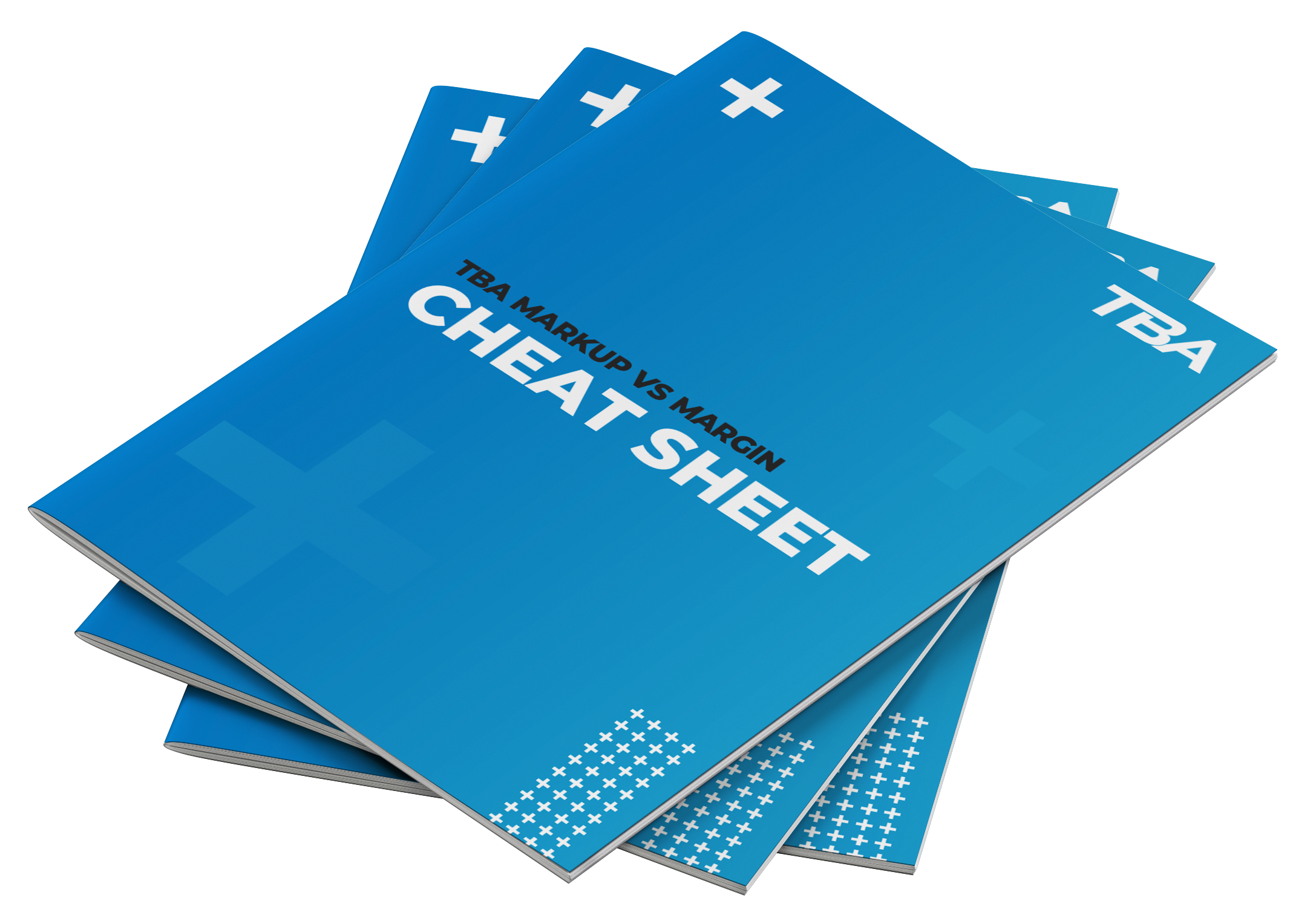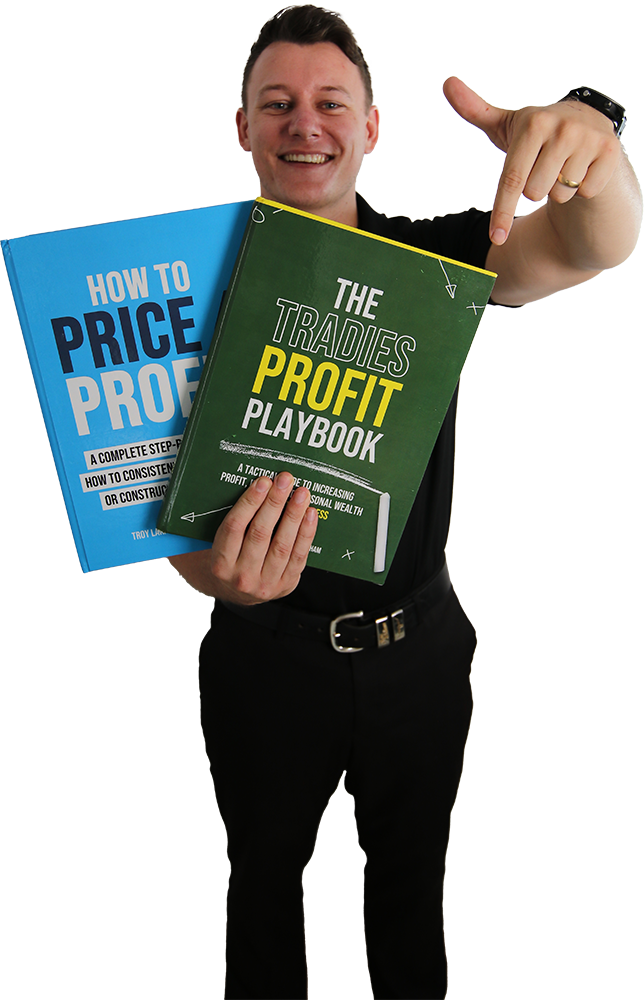One of the biggest pricing mistakes that I see trade and construction business owners making is confusing the relationship between markup and margin.
And what this typically looks like is going into a job, working out what it’s going to cost to deliver it, then slapping on a 50% markup… thinking that you’re going to make a 50% gross profit margin.
But this isn’t the case at all.
In fact, in this instance, if everything goes to plan you’re actually only going to achieve a 33% Gross Profit Margin, despite marking up your job costs by 50%.
Now, if you’re not sure why that’s the case… then this article is for you.
I’m going to breakdown exactly what the difference between markup and margin is, why you need to know this when you’re pricing your jobs and projects, and exactly how you can start making thousands and thousands of dollars’ worth of more profit moving forward.
Let’s dive in.
First things first...
Markup and margin are NOT the same thing…
I hear people sometimes saying things like… I’ve added a 15% margin to my labour and materials… but often in these instances there actually talking about markup and this is costing them a lot of money, so what is the difference between the two?
The difference between Markup and Margin.
Well, margin is the total selling price of your job or project, minus the costs to deliver it all.
In simple terms, the gross profit you make on all your jobs.
And to calculate our gross profit margin we use the formula:
(Total sale price – Total costs) / Total sale price = Gross Margin
Whereas markup on the other hand… is how much you add to the raw costs to deliver a job or project… to get it to your total selling price that sits on the quotes you give your clients and customers.
So, in simple terms, it’s a tool you can use to get you a better profit margin on your jobs.
And to calculate our markup we use the formula:
(Total sale price – Total costs) / Total costs = Markup
Now, if we confuse the two of these, we can actually fool ourselves into thinking we’re going to be making a much better profit margin on our jobs and projects then we really are.
And the best way to understand this is through an example.
Let’s say for simple’s sake, you’re quoting a job and you estimate there to be $10,000 in direct job costs, across your labour, materials, equipment hire and what have you…
Now, if you were to mark up those job costs by 50%, that would mean your Gross Profit on this job would come to $5,000 because $10,000 times 50% equals $5,000.
And so that 50% markup makes the total quote, or final sale price of your job $15,000.
$10,000 in costs, and $5,000 in gross profit from our 50% markup.
But this doesn’t mean we’re making 50% profit.
In fact, our gross profit on this job is actually only 33%.
And this is because the $5,000 in gross profit is 33% of the total sale price of $15,000.
So, marking up our job by 50% allowed us to make a 33% gross profit margin.
Now, the problem here is that if you don’t understand the difference between markup and margin, and you think that marking up your job by 50% will mean you will achieve a 50% gross profit margin…
You’re actually making 17% less profit than you think you are!
The 33% is what you get to keep, NOT the 50% you thought you were getting…
So, it’s no wonder why so many trade business owners out there are pricing jobs, thinking there’s a lot of fat in them, but once they finish the job, collect their money and then look at their bank account, what they expected to be there, just isn’t there…
It’s all because they’re confusing their markup with their margin!
And this is why that relationship is so important to understand when pricing your jobs.
Because if you change the way you’re pricing to focus solely on your margin and using markup as a tool to get there… rather than thinking markup is your margin… you’re going to make significantly more money in your business, and that’s a guarantee.
Setting Gross Profit Targets.
Now, in alignment with that, what you want to do is set gross profit margin targets for your different work types.
Establish benchmark gross profit targets based off how much money you want to earn in the year and what your overheads are…
For example, you might want to earn $300,000 in operating profit, and you might have $800,000 in overheads… making your gross profit target $1.1M…
Then to get your percentage you estimate you’re going to do $3M in sales over the next 12 months…. And then you divide $1.1M by $3M to give you a 37% gross profit margin target.
This way you have a profit target that you’re aiming for on your jobs and projects before you pull the trigger on any quotes.
Without the target, you don’t know what to aim for and so your markup is likely going to just be a random amount with no real strategy behind it – you need to start with the end in mind… how much money do YOU want to earn!
NOTE: For more information on how to do this click here.
How to calculate what Markup to use.
Now that you know how what gross profit margin you need to be aiming for, you now need to know what markup to use to hit that target…
Because like I was saying earlier, if you were to just add a 37% markup to your job costs because you need to hit a 37% gross profit margin… this isn’t going to get you there…
So, to calculate the markup you need to use, use the following equation:
Markup = Margin / (1 – Margin)
Then to calculate your total quote price use the following equation:
Sell Price = Costs x (1 + Markup)
For example…
We need to hit a 37% margin, so:
Our Markup = 0.37 / (1 – 0.37) = 0.59
And then our total Sell Price = $10,000 x (1 + 0.59) = $15,900
So, at the end of the day, markup is just a tool to help you price for margin!
A profitable quote price isn’t about just adding on a random percentage to your job costs…
It has to be precise to what you’re looking to achieve.
Back costing all your jobs and projects.
And now that you understand the difference between markup and margin and you’re pricing based off your gross profit margin targets, and you know what markup to use to hit those targets, now you want to know if you’re actually making that profit on your jobs.
And this is where back costing comes into play.
Back costing is the process of comparing what profit we actually made on a job or project with what we originally estimated we’d make.
So, basically just comparing our original quote with what actually happened.
How much profit did we expect to make, versus how much profit did we actually make…
And this is really important to get that feedback loop of how we’re really going on our jobs because it’s all well and good to quote a job at a 50% gross profit margin… but if we’re only making 20% or we’re even losing money then we need to know and we need to know why.
It could be an estimation error and not allowing enough for the job, it could be blow outs in delivery or inefficiency from your crews, it could be wastage of materials… you know… whatever the reason… getting the feedback on how you’re actually performing will allow you to adjust and better prepare for the next job to ensure that you are getting the profit you anticipate and deserve!
An example of this is one of our plumbing clients.
When we first started working together, he didn’t really understand the relationship between markup and margin, and he wasn’t sure what gross profit he was making on his jobs.
All he’d really focus on from a number’s perspective was how many sales he was making every month.
But when we back costed jobs, we discovered that he wasn’t making enough and there was no consistency to his pricing…
26%, 45%, 24%, 38%, 40%, 32%, 26%, 22%, 10%, 34%, 42%, 22%, 33%, 17%, 28%, 21%... gross profit margins...
And after establishing how much money he actually wanted to earn, his overheads, and then gross profit margin targets, in a matter of months he was back growing his top line sales but now with far greater profits.
In fact, his gross profit margin across every job was either 50%, 60%, or even up to 70%.
Never dropping below 50%.
This is why it’s also important that you not only understand markup and margin, but also back costing your jobs to understand how you’re really going to be able to assess what's working and what isn't for the next one.
Because just like our client, you too could be leaving significant amounts of money on the table.
So, to summarise:
- Markup and Margin are NOT the same thing
- When pricing jobs focus on Margin and using Markup as a tool to get there
- Base your Gross Profit Margin on jobs off of pre-set targets
- Back cost all your jobs and projects to see how you’re performing
If you follow these steps, you’ll be well on your way to making a lot more money in your trade business!
Markup vs Margin Cheatsheet.
And to help get you started with everything I’ve discussed today I’ve actually put together a FREE Cheat Sheet that you can download below.

The cheat sheet has all the notes on what markup and margin are, the examples we covered, and it has a table showcasing exactly what markup to use for any specific gross profit margin target, so you don’t have to worry about the maths.
If you're an electrician, plumber, painter, carpenter, or any other tradie business owner turning more than $1M a year looking for assistance with your tax, accounting, bookkeeping, and business advisory - click here to learn more!

